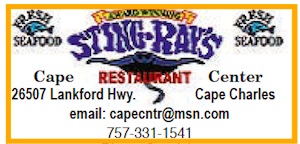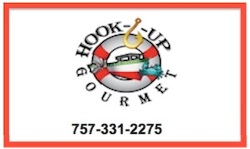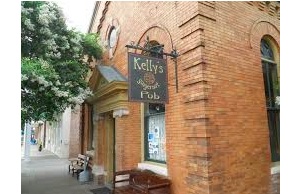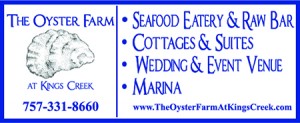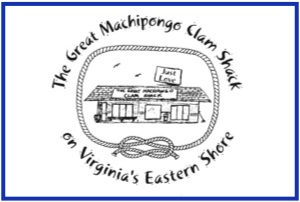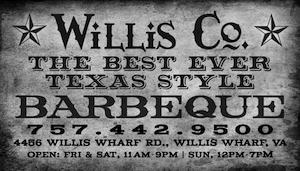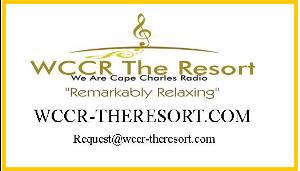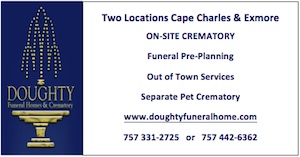ORAL HISTORY
‘To Think Daddy Sold the House for $20,000!’
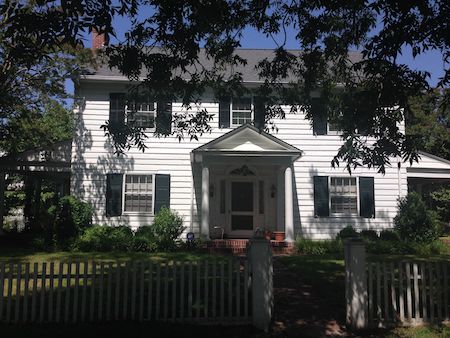
“One of the prettiest houses in town”: Randolph Avenue home was built c.1945 and purchased by the Wendell family c.1958 for $20,000. The home remains in the family today. (Wave photo)
September 2, 2014
Cape Charles Historical Society has for more than a decade been recording oral histories of the area’s earlier days. A grant from the Virginia Foundation for the Humanities enabled 15 interviews to be transcribed, and the Historical Society has made this one available for readers of the Wave.
1990 Interview of Virginia Fitzhugh conducted by Virginia Savage
PART SIX
VIRGINIA SAVAGE: There’s a house [southwest corner of Randolph and Peach] owned by Ham Hamilton. He was married to a Whitehead [from Townsend — two doors east of Miss Iva].
VIRGINIA FITZHUGH: They’re related in some way. You know you can’t talk about anyone around here, Virginia, because everyone is kin!
You know, I found that early! When I came to the Eastern Shore I found out in a hurry you don’t talk about anybody because everybody was kin!
That’s where Carrie King lived for years [before she built her house]. Yeah, she lived there for years and years, Carrie King. Now who built it, I don’t know.
Now which house is that?
Where Ham Hamilton lived on that corner.
Tazewell and Peach. Then Carrie built the house up Randolph Ave that the Wendells now live in. And I think she must have built that about 1945. You know, in about 1958 we bought what was the Dr. Lynch house, the Dr. Moore house before that, we didn’t pay but $7,500 for that house. And the Wendells bought Aunt Carrie’s house not long after that and I don’t think they paid but $20,000 for that and that was one of the prettiest houses in town.
Dr. Lewis Belote, the dentist, only paid $20,000 for the Moore house. [Jack Moore house on Bay Avenue.] And that came right from Elizabeth. Because you know when Joan wanted to sell it, she wanted $100,000 and Elizabeth had a fit. She said, “My Lord, my Daddy sold that to Lewis Belote for $20,000 and I think left the piano in there.” [Bobby Rittenhouse has it.]
And that was thirty years ago, because I think Wade was about two years old when they moved into that house, because I kept him during that period of time. He and Jake were buddies. So that was about thirty years ago, they paid $20,000 for that house. Isn’t that amazing!
Elizabeth said she just couldn’t get over it. To think Daddy sold it for $20,000. [Read more…]
ORAL HISTORY: Parsons House Fire Was ‘Worth It’
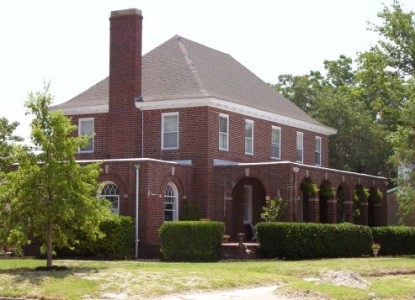
Parsons House burned c. late 1970s. The five dormers were lost along with the Chippendale railing around the upper porch and the slate roof. The house is now the Chesapeake Bay View Bed & Breakfast.
August 18, 2014
(EDITOR’S NOTE: Cape Charles Historical Society has for more than a decade been recording oral histories of the area’s earlier days. A grant from the Virginia Foundation for the Humanities enabled 15 interviews to be transcribed, and the Historical Society has made this one available for readers of the Wave. All the transcriptions may be read at the Cape Charles Museum.CLICK to read previous oral histories in the Wave.)
1990 Interview of Virginia Fitzhugh conducted by Virginia Savage
PART FIVE
VIRGINIA SAVAGE: Where was the Fitzhugh house?
VIRGINIA FITZHUGH: Right there on the corner where Shrieves lives [southwest corner of Randolph and Peach].
The yellow house on the corner of Peach and Randolph. And that’s where you started housekeeping. Did Mr. Fitzhugh build that house?
No. That house was built by Dr. Kellam, the doctor that was in Cape Charles. And Mr. Fitzhugh bought it from him.
Now the house next to that where the Johnsons lived now. And the next house was Harold Smith’s.
That’s right. That was a boarding house.
That was an old Federal type building there [torn down in the ’80s]. Do you remember when the Mack buildings were built?
Yep. They were built late. I would say ’30s or ’40s.
Do you remember when Mr. Parsons built his house on the beach? Mr. Russell Parsons . . . Miss Alice Parsons. The one the second floor burned probably during the late ’70s.
I don’t know how old I was when that was built.
That was such a gorgeous house. What a calamity that it burned. [The five dormers were lost, the Chippendale railing around the upper porch and a wonderful slate roof.]
Listen, it was worth it. They got so much money back, because it had gone perfectly terrible and they didn’t have the money to fix it. But how in the world they got so much insurance money — it’s like an almost entirely new house inside. I tell you, Virginia, Miss Alice Parsons had property but I don’t think she had much cash. Because she was a working woman. She had all those apartments up over where Harold Smith had his hardware store. And up there where the Eastern Star was. [Parson building on Mason.] See they had apartments up there. They owned all these big houses at the end of Tazewell. [Read more…]
ORAL HISTORY: More Monroe Avenue Houses
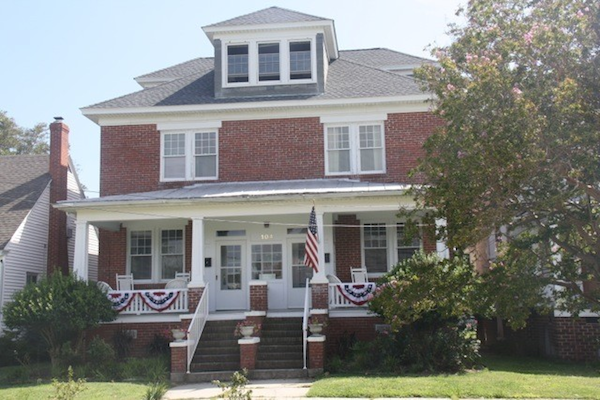
104 Monroe Avenue, built c. 1923 by Miss Lina Taylor but known by most locals as the Bull House, where schoolteacher Ruby and husband Ryland Bull lived for many years. (Wave photo)
July 14, 2014
(EDITOR’S NOTE: Cape Charles Historical Society has for more than a decade been recording oral histories of the area’s earlier days. A grant from the Virginia Foundation for the Humanities enabled 15 interviews to be transcribed, and the Historical Society has made this one available for readers of the Wave. All the transcriptions may be read at the Cape Charles Museum. CLICK to read previous oral histories in the Wave.)
1990 Interview of Virginia Fitzhugh conducted by Virginia Savage
PART FOUR
VIRGINIA FITZHUGH: When we lived on Randolph Avenue, Miss Lina Taylor lived across the street from us. And when Daddy built [on Tazewell and Pine] down there, she said that town was so lonesome up there that her neighbors had moved, she bought a piece of property and built on Monroe Avenue.
VIRGINIA SAVAGE: I love that house. And she would be pleased to know that the stairwell is back in it and it’s no longer two stories. Did she have a family?
She had Gordon Ames and Winton. Now, Gordon, you remember Cary Ames? Well, that was one of Miss Taylor’s sister. See that double house in back of us, Miss Taylor built. She sold that house to Dixon, that’s on the corner where the B&B is now. Mr. Dixon was a painter, paper hanger.
Now that’s always been referred to as the Dixon house. He’s the one that turned it into two apartments then.
That’s right.
Because when I first came over to the shore, you had to go up a back staircase to get to Bond Disharoon’s apartment.
And Miss Taylor built that big, brick double house in back of ours, where Ruby Bull lived; they lived there for years. That’s right, the Schrecks were living in one part. Then Miss Taylor died and Marie married and went to New York and they sold that house to Ryland Bull. See, Ryland lived up the street in that double house that’s across from Ethel May [500 block of Monroe]. And he sold that and bought the double house of Miss Taylor’s. Cary Ames was the daughter-in-law. the son was Gordon. He built the house they lived in. [Read more…]
ORAL HISTORY
Randolph, Tazewell, and Bay Avenue Houses
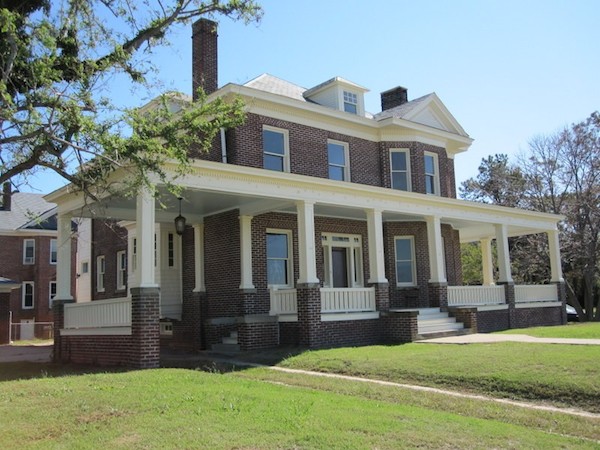
Mr. E.P. Dryden operated a grocery store on Mason Avenue when he built this residence in 1912 on the corner of Bay and Tazewell. The house was recently magnificently restored by a Richmond family.
June 16, 2014
(EDITOR’S NOTE: Cape Charles Historical Society has for more than a decade been recording oral histories of the area’s earlier days. A grant from the Virginia Foundation for the Humanities enabled 15 interviews to be transcribed, and the Historical Society has made this one available for readers of the Wave. All the transcriptions may be read at the Cape Charles Museum.)
1990 Interview of Virginia Fitzhugh conducted by Virginia Savage
PART THREE
VIRGINIA SAVAGE: Let’s talk about Randolph Avenue. You lived in the Wilkins house. Now that was the Wilkins that built what is now the Methodist Parsonage. And the other Wilkins was Elliott’s grandfather. And then he built both of those houses. The Eleanor Lowe house I believe is next and Mr. Jack Scott built that for her. Do you remember when that was being built?
VIRGINIA FITZHUGH: No. Eleanor was older than me, and I don’t remember. You know, Virginia, back in those days you didn’t roam around town like the kids do today. You just went so far and that was it. You just had your group of friends. He built that and the one next to that is that bungalow and that was built by Sterling, a man named Sterling.
I think a Miss Sterling lived in that when I came here.
No, a Mrs. George Guy. She was a caretaker.
What did the Sterlings do?
Well, you know where Lee Sterling lives. Well, that house was on the corner where the Post Office is now. That house has been moved and turned around and that was the Sterling house.
This is the house across Tazewell Avenue and one from the corner from the Presbyterian Church that you’re talking about. The great big house and they moved it back. There was an explosion in the late ‘60s and it burned. A new house has been built, very close in type to the old houses. Lee Sterling worked at Colonial Store.
That’s right. That’s where the Sterlings lived. I think some of that property still belongs to the Sterling girls, Josephine and I think her sister. [Read more…]
ORAL HISTORY
1933 Hurricane, Rowing to the Post Office
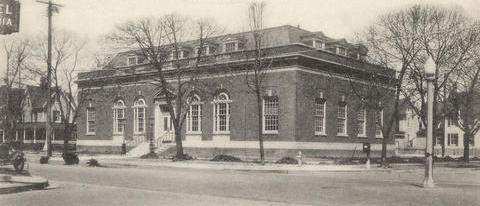
Cape Charles Post Office in 1933, the year it opened and the year of the hurricanes. (Kirk C. Mariner Collection)
May 27, 2014
(EDITOR’S NOTE: Cape Charles Historical Society has for more than a decade been recording oral histories of the area’s earlier days. A grant from the Virginia Foundation for the Humanities enabled 15 interviews to be transcribed, and the Historical Society has made this one available for readers of the Wave. All the transcriptions may be read at the Cape Charles Museum.)
1990 Interview of Virginia Fitzhugh conducted by Virginia Savage
PART TWO
VIRGINIA SAVAGE: I am talking to Virginia Fitzhugh, who was born and raised in Cape Charles. Virginia, Who was May Beth’s mother and father?
Mr. and Mrs. Taylor. They had the drugstore down on Front Street where Jack MacMath later had a drugstore. Mallory Taylor, that was her mother and father. She was much older than me. She would have been in her hundreds.
The house next to the Miller house, coming east, was built by Mr. Wilkins and that’s Elliott Wilkins’ grandfather?
Yes. He was Tucker Wilkins’ father. Old Man Wilkins lived there and Mandy Tate, because we rented from them. I lived where Joe Restein lived for five or six years [1 Randolph Ave]. After we were married. We wanted to buy it, but Old Man Wilkins wouldn’t sell it to us.
Now let’s come down this side of the street and that side, too. There was another Wilkins built that house and the next house, the Leatherburys were living in it when I came over here. And then Ray Hickman bought it, and Bonny owns that now. Did Leatherburys build that house, do you know?
Yes.
Cross over the street, and the house that you are talking about, Joe Restein’s, the Aubrey Nottinghams lived there before that. Now take me back in that house.
We lived there. Now, who lived there in the beginning, I can’t say.
Now, somewhere along the line Edna Bounds’ mother lived there because Edna told me her mother built that house. Elliott said no way.
No, ma’am. Elliott’s grandfather built that house. He built that house, the house next door to it. Ruth Kerr lived in it. And when we wanted to buy that from Mr. Wilkins, he said that he had made a house for each one of his children. And he was leaving the houses to his children. And what they did after he passed away, that was up to them. But that was the only legacy that he had to leave to them. So this house was to go to one of his children and the one next door and, of course, the one they lived in.
We lived there for five or six years, and I guess we would have kept on living there if it hadn’t been that Daddy died. And Mother, she didn’t know how to do one thing, so we had to move back in with Mother. But we did want to buy that house real bad, because we had done a lot of things to it. We loved the beach and where it was. We lived there when the first hurricane came. We went to bed that night and we thought it was a Nor’easter. We slept like babies! And slept through it. Edie Jean was small and they were in a room facing the beach and they had twin beds in there. And I always went in to look at them before I went downstairs to get breakfast. And I looked out the window and I said, “Everybody get up quick! We’re in the middle of the Chesapeake Bay!” See that’s when the water went all the way up to the Post Office. And there was a man named Sterling and he rowed a rowboat from his house right up to the Post Office. [Read more…]
ORAL HISTORY: How Harbor Avenue Got its Skew
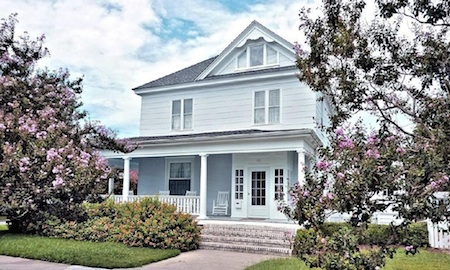
101 Tazewell Avenue, corner of Harbor, was “right on the beachfront” when built by Capt. Sadler c. 1912. Later, Harbor Avenue layout was skewed to accommodate the house.
May 19, 2014
(EDITOR’S NOTE: Cape Charles Historical Society has for more than a decade been recording oral histories of the area’s earlier days. A grant from the Virginia Foundation for the Humanities enabled 15 interviews to be transcribed, and the Historical Society has made this one available for readers of the Wave. All the transcriptions may be read at the Cape Charles Museum.)
1990 Interview of Virginia Fitzhugh conducted by Virginia Savage
PART ONE
VIRGINIA SAVAGE: I am talking to Virginia Fitzhugh, who was born and raised in Cape Charles. Virginia, what was your maiden name?
Virginia Sadler. I was raised in Cape Charles. I was born next door to the old Virginia Hotel and the Henderson Travis House. [Across from the Post Office, on the southwest corner. Her father was Capt. Sadler, a NYP&N steamer captain.]
West side of Virginia Hotel? Which would be right across from the Post Office on the corner of Strawberry and Randolph.
That’s where I was born. And then Daddy bought the house up in the middle of the block on Randolph. I don’t know who lives there now but he bought right in the middle. Alva Stiles used to live there. And then Daddy built the first house that was built this side of Pine Street other than the house that was back in the woods. And he bought the lot from the Scott Estate and built down there. And we thought we were right on the beachfront. The corner of Tazewell and Harbor.
Did he have to build that house on pilings?
No. He happened to get the house part of the land that was down there. And see, the beach came right up to Harbor Avenue. Sand and everything. That’s a built in place from Harbor right up to beachfront. That was sand that was blown up and built up all that up there. Daddy thought he was right on the beachfront.
Isn’t that amazing! I knew that Jeannette Edgerton’s house, for one, was built on pilings.
Well, all those apartments across from us, they’re all built on pilings. And we used to watch them and the pile driver would hit one and it would go out of sight and they’d have to put another one right on top of it. You see, that’s all swamp there. And because it had the cat o’ nine tails and the grass that grows on the beach and all that stuff. [Read more…]
ORAL HISTORY: Last Words from David Mitchell
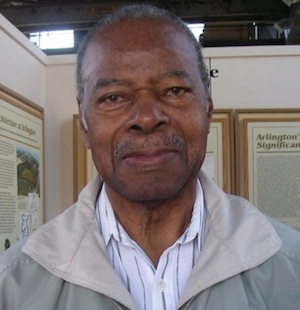
David Mitchell today (13 years after his remarks transcribed here). Photo courtesy Marion Naar
April 21, 2014
(EDITOR’S NOTE: Cape Charles Historical Society has for more than a decade been recording oral histories of the area’s earlier days. A grant from the Virginia Foundation for the Humanities enabled 15 interviews to be transcribed, and the Historical Society has made this one available for readers of the Wave. All the transcriptions may be read at the Cape Charles Museum.)
David Mitchell speaks April 12, 2001
PART 5
[Audience]: “When you were in the ball club and traveling, did you go on a bus? Did you sleep on the bus?
Oh yes, we had a bus. We always had hotels that we would go to stay in. I had a kind of hairy experience coming out of Upstate New York. We played up in Utica and Ithaca, New York. We were coming down from there and what happened, the bus had broken down in New York and we had to hire a limousine to take the team, there were 18 heads. Coming back, the left front tire blew on this limousine and we were coming down this mountainside. And the driver hollered, “Don’t nobody touch it!” He was afraid someone would grab the wheel and try to steer it. We came to a stop right to a guard rail and nobody got hurt, didn’t even scar the car or anything, but that was something that lived with me for a long time, because if we had gone over . . . . There was a 50 or 75 foot drop down there and I guess all of us could have been killed or get broken bones or something.
We were staying in a hotel in New York on 7th Avenue, I can remember a young lady that had been down here visiting and all she was talking about was this Glass house in Cape Charles. It’s the house right across from where Raymond Spady lives, that was new at that time. Somebody described it to her as the Glass House and so she wanted to see it. So this lady was visiting my friend’s girlfriend and this particular night we were going out and I didn’t have a date, so they asked me if I would mind taking this girl along. I said fine.
After taking her out that night, I took her out the next day and showed her the sites, the farm, the houses and different places. And she enjoyed it so much, that she told me that if I was ever in New York, to please come by and see her. She told me about her boyfriend and everything. [Read more…]
ORAL HISTORY: Questions for David Mitchell

David Mitchell today (13 years after his remarks transcribed here). Photo courtesy Marion Naar
April 14, 2014
(EDITOR’S NOTE: Cape Charles Historical Society has for more than a decade been recording oral histories of the area’s earlier days. A grant from the Virginia Foundation for the Humanities enabled 15 interviews to be transcribed, and the Historical Society has made this one available for readers of the Wave. All the transcriptions may be read at the Cape Charles Museum.)
David Mitchell speaks April 12, 2001
PART 4
[Audience]: “What are you doing now?”
I do odd jobs. I cut grass. Mrs. Restine was the first person I cut grass for and I did it up until she died. In fact, I bought my first lawn mower in 1959 and I’ve been cutting grass ever since then. I don’t go out and look for work, it’s just a few people I do it for. As I told the man the other day, I don’t want to go out and them tell me I need to get a license. It’s a charitable thing mostly. This young fellow [indicates Clarence Smaw] over there, he helps me out at church. He’s retired from the railroad. He said he noticed at the church anytime they needed somebody to do something, they always called on me. He said, when I retire, I’m going to help him. So he’s been 100%. This other young man [indicating James Braxton], he’s at the church, we’ve been pals for many, many years.
We used to go out once or twice a year for a day, just the three of us. The driver was the only one who knew where they were going. Sometimes you could change your mind, but nobody would know because you were the only one who knew where you were going. Like what happened to him, he was going to work on a Monday morning and we were out on a Sunday run. He said, isn’t it something, I’ve got to come right back up the road tomorrow and go to work. He worked up in Delaware. Well, I was heading up that way, so when I got in Delaware, I turned and changed my plan and went to Baltimore. I didn’t want to go over the same route he was going to go over! We would just have a lot of fun riding, talking, and stopping with no particular place to go and no time to get there. We used to do it quite often, but after my son got sick and my wife’s mother got up in age, she had to look after her. We haven’t been out, but we hope someday soon we will be.
I had a fun experience with Herb Lovitt. He and I used to have a little talk about different things and I would disagree just to get him wound up. He got a little upset one night, got a little rough. I was riding with him — one night I would drive carrying us to work and he would drive the next — I said to him, “You wait until we get home and I’m going to tell you something.” He was very quiet all the way home and he didn’t know what was going to happen. So I got out of the car and just said, “So long, Herb, have a nice day!” And he was shocked. [Read more…]


